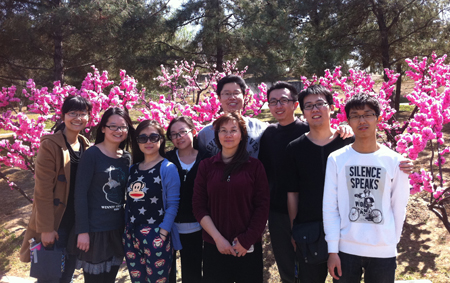
Principal Investigator,Professor : Biofilm Research Group

1.Das, P., Yang, X.-P., and Ma, L. Z. * (2014) Analysis of biosurfactants from industrially-viable Pseudomonas strain isolated from crude oil suggests how rhamnolipids congeners affect on emulsification property and antimicrobial activity. Front. Microbiol. doi: 10.3389/fmicb.2014.00696.
2.Wang, S., Yu, S., Zhang, Z., Wei, Q., Yan, L., Ai, G., Liu, H. Ma, L.Z.* (2014) Coordination of swarming motility, biosurfactant synthesis, and biofilm matrix exopolysaccharides production in Pseudomonas aeruginosa. Appl. Environ. Microbiol. 80: 6724-6732.
3.Wang, S., Parsek, M.R., Wozniak, D.J. and Ma, L-Y.* (2013) A spider web strategy of type IV pili-mediated migration to build a fibre-like Psl polysaccharide matrix in Pseudomonas aeruginosa biofilms. Environ. Microbiol. 15(8): 2238-2253
4.Wei Q., Ma, L. Z. * (2013) Biofilm matrix and its regulation in Pseudomonas aeruginosa. Int J Mol Sci. 14, 20983-21005
5.Ma, L-Y.*,Wang, J., Wang, S., Anderson E.M., Lam J.S., Parsek, M.R. and Wozniak, D.J. (2012) Synthesis of multiple Pseudomonas aeruginosa biofilm matrix exopolysaccharides is post-transcriptionally regulated.Environ. Microbiol.14 (8):1995-2005.
6.Ma, L-Y.*, Wang, S., Wang, D., Parsek, M.R., and Wozniak, D.J. (2012) The roles of biofilm matrix polysaccharide Psl in mucoid Pseudomonas aeruginosabiofilms. FEMS Immunol. & Med. Microbiol. 65:377-380.
7.Ma L.,Liu X-Y., Liang H-H., Che Y-Z., Chen C-X., Dai H-Q., Yu K, Liu M., Ma, L-Y., Yang C-H., Song F-H., Wang Y-Q., and Zhang L-X.(2012)Effects of 14-Alpha-Lipoyl Andrographolide on Quorum Sensing in Pseudomonas aeruginosa. Antimicrob.Agents and Chemother. 56:6088-6094.
8.Ma, L-Y., Wang, S., Yang, J-Z., Zhang, Z-Y.(2012)Mechanism of biofilm formation. < Microbial Biofilm and Infection> People's Health Publisher. p1-34.
9.Ma, L-Y.,Conover, M., Lu, H., Parsek, M. R.,Bayles, K. and Wozniak, D.J. (2009) Assembly and development of the Pseudomonas aeruginosa biofilm matrix.Plos Pathog. 5: e1000354.
10.Byrd, M.S., Sadovskaya, I., Vinogradov, E., Lu, H., Sprinkle, A., Richardson, S.,Ma, L-Y.,Ralston, B., Parsek, M.R., Lam, J. and Wozniak, D.J. (2009) Genetic and Biochemical Analyses of the Pseudomonas aeruginosa Psl Exopolysaccharide Reveals Overlapping Roles for Polysaccharide Synthesis Enzymes in Psl and LPS Production. Mol. Microbiol.73(4) 622-638.
11.Starkey, M., Hickman, J.H.,Ma, L-Y., Zhang, N., Long, S.D., Hinz, A., Palacios, S., Maoil, C., Kirisits, M., Starner, T., Wozniak, D.J., Hardwood, C.S. and Parsek, M.R. (2009) Pseudomonas aeruginosa rugose small colony variants have adtaptions that likely promote persistence in the cystic fibrosis lung. J. Bacteriol. 191:3492-3503.
12.Huigens, R. W., Ma, L-Y.,Gambino, C. D., Moeller, P.D., Basso, A., Cavanagh, J. D., Wozniak, J., and Melander, C. (2008) Control of bacterial Biofilms with marine alkaloid derivatives. Mol Biosyst. 4(6):614-621.IF=3.534
13.Ma, L-Y.,Parsek, M. R.and Wozniak, D.J. (2007) Pseudomonas aeruginosa Psl is a galactose- and mannose-rich exopolysaccharide.J. Bacteriol. 189:8353-8356.
14.Ma, L-Y.,Jackson,K.,Parsek, M. R.and Wozniak, D.J. (2006) Analysis ofPseudomonas aeruginosa conditional Psl variants reveals roles for the Psl as an adhesin and in maintaining biofilm structure post-attachment. J. Bacteriol.188:8213-8221.
15.Taghbalout,A.,Ma, L-Y.andRothfield, L. (2006)Role of MinD-membrane association in Min protein interaction.J. Bacteriol. 188:2993-3001.
16.Cui, Y., Tu, R., Guan, Y.,Ma, L-Y.and Chen, S.(2006) Cloning, sequencing, and characrization of the Azospirillum brasilense fluE Gene.Curr. Microbiol.52(3):169-177.
17.Ma, L-Y.,King, G. And Rothfield, L. (2004) Positioning of MinE and MinC binding sites on the MinD surface provides a plausible mechanism for activation of the E. coli MinD ATPase during division site selection.Mol. Microbiol.54(1):99-108.
18.Schimanski, B.,Ma, L-Y.andGunzl, A.(2004) Failure to detect binding ofTrypanosoma brucei SNAPc to U2 and U6 snRNA genes byin vitrotranscription competition and pull-down assays. Mol & Biochem. Parasitol.137:293-296.
19.Ma, L-Y.,King, G. and Rothfield, L. (2003) Mapping the MinE Site involved in interaction with the MinD division site selection protein of Escherichia coli. J. Bacteriol.185:4948-4955.
20.Desnoues, N., Li, M., Guo, X.,Ma, L-Y., Carreno-Lopez, R. and Elmerich, C.(2003) Nitrogen fixation genetics and regulation in Pseudomonas stutzeri strain associated with rice.Microbiol.149:2251-2262.
21.Wang, J , Chen, S-F., Ma, L-Y., , Li, J-L.(2001) Cloning , sequencing and expression pattern, functional analysis of nifA in Azospirillum brasilense Yu62.Acta Microbiologia Sinica. 41:655-661(in Chinese ).
22.Ma, L-Y., Wu, Y. Wang, J., Zhao, Y-S., Li, J-L.(1999) Site-directed mutagenesis analysis of draTG genes and their downstream region from Azospirillum brasilense Yu62. Chinese J. of Biotechnology 15:281-287 (in Chinese ).
23.Ma, L-Y. and Li, J-L.(1998) Advance in genetics researches of nitrogen fixation(a review). In Engineering of Agriculural Biology. Man, K-Q., Chen, S-Y., Li, J-L., Zhu, Y-D.(eds.). Chemical Industry Publisher. p15-48. (in Chinese )
24.Ma, L-Y. and Li, J-L.(1997) Advance in genetics of Azospirillum and plant-root interactions (a review). High Technology letters 11:56-59. (in Chinese )
25.Ma, L-Y. and Li, J-L.(1997) Sequencing and analysis of function of the upstream region of draTG genes from Azospirillum brasilense Yu62. Chinese J. of Biotechnology 13(4):343-349 (in Chinese and English).
26.Ma, L-Y. and Li, J-L.(1997) Cloning and sequencing of draTG genes and downstream region from Azospirillum brasilense Yu62. Chinese J. of Biotechnology 13(3):227-235 (in Chinese and English).
27.Yan, D-L., He, L-H., Ma, L-Y., Li, J-L.(1995) Effect of Klebsiella pneumoniae nifA on the regulation of nif gene expression by ammonia in Azospirillum brasilense. Chinese J. of Biotechnology 11(4):385-388. (in Chinese )
28.Yan, D-L., He, L-H., Ma, L-Y., Li, J-L.(1995) Transcriptional activation ofAzospirillum brasilense nifH promoter by NifA of Klebsiella pneumoniae. Chinese J. of Biotechnology 11(3):205-210. (in Chinese)
29.Ma, L-Y., Yan, D-L., He, L-H., Li, J-L.(1994) Insertion mutagensis used in nitrogen-fixing bacteria (a review). Microbiology 21:101-105 . (in Chinese )
30.Nan, Q-X., Ren, F-ZH., Yang, Z-B., Zhang, X-J., Ma, L-Y.(1992) Studies on the forming process of milk fan in Yun nan province. Chinese J. of Animal Science 28(2):25-27.